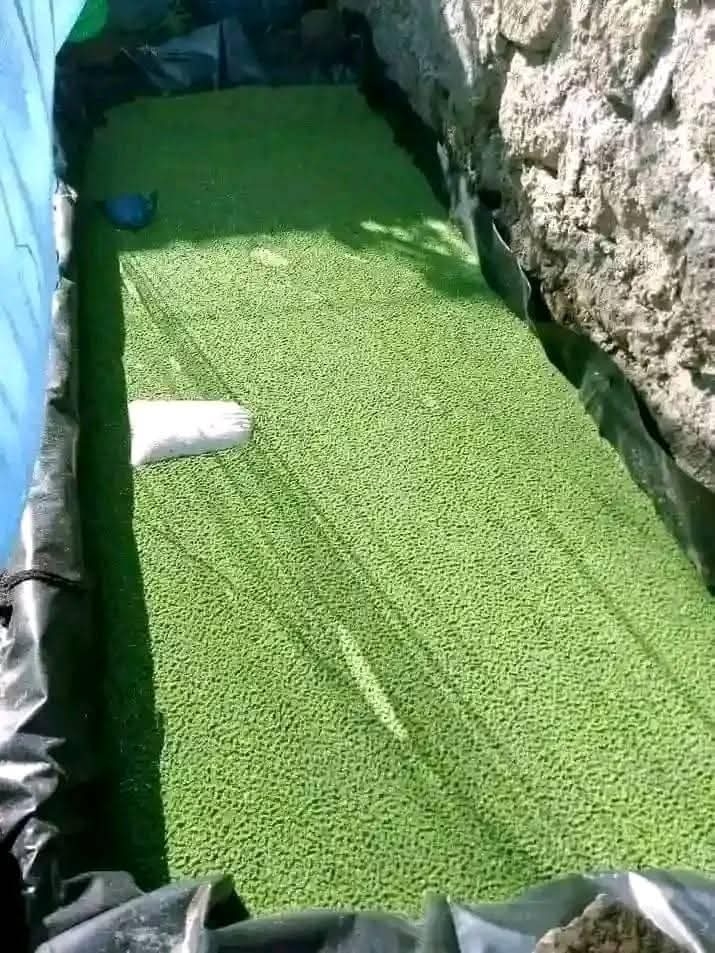If you’re looking to build an Azolla pond that is durable, efficient, and low maintenance, installing geomembrane liners is a game-changer. Geomembrane liners provide waterproofing, durability, and an optimal growing environment for Azolla, making them a must-have for any farmer or aquaponics enthusiast.
In this detailed guide, you’ll learn everything you need to know about installing geomembrane liners for Azolla ponds, step-by-step. We’ll include interactive visuals, case studies, comparison tables, and FAQs to help you master the process.
Table of Contents
- What are Geomembrane Liners? 🛢️
- Why Use Geomembrane Liners for Azolla Ponds? 📈
- Types of Geomembrane Liners 🌧️
- Tools and Materials Needed 🔧
- Step-by-Step Installation Process ✅
- Cost Comparison Table 📏
- Case Study: Transforming Azolla Production with Geomembrane Liners 🔦
- FAQs 🔍
- Final Tips and Call to Action 📢
1. What are Geomembrane Liners? 🛢️
Geomembrane liners are synthetic membranes made from materials like HDPE, LDPE, or PVC. They act as a waterproof layer that prevents water seepage, providing a controlled environment ideal for Azolla farming.
Quick Fact: Azolla can double its biomass within 3-10 days in the right conditions!
Key Benefits of Geomembrane Liners:
- Prevent water loss due to seepage.
- Improve water quality by reducing contamination.
- Enhance durability and longevity of ponds.
- Ensure consistent growth of Azolla with minimal maintenance.
2. Why Use Geomembrane Liners for Azolla Ponds? 📈
The Problem:
Traditional earthen ponds face challenges such as:
- Water seepage causing frequent refilling.
- Weeds and contamination affecting Azolla growth.
- Limited control over water quality.
The Solution:
Geomembrane liners eliminate these issues, ensuring:
- Up to 98% water retention.
- A clean, controlled growing space for Azolla.
- Lower maintenance costs over time.
Stat: Farmers using geomembrane liners report a 50% increase in Azolla yield compared to earthen ponds.
3. Types of Geomembrane Liners 🌧️
| Type | Material | Durability | Cost | Best For |
|---|---|---|---|---|
| HDPE Liners | High-Density Polyethylene | 20+ Years | Moderate | Large ponds with high durability needs |
| PVC Liners | Polyvinyl Chloride | 10-15 Years | Low | Small ponds with a budget focus |
| LDPE Liners | Low-Density Polyethylene | 5-10 Years | Low-Moderate | Temporary or smaller Azolla ponds |
Pro Tip: For Azolla ponds, HDPE liners are highly recommended due to their long lifespan and chemical resistance.
4. Tools and Materials Needed 🔧
Before starting, gather these tools:
- Geomembrane liner roll (HDPE, PVC, or LDPE).
- Measuring tape and marker.
- Utility knife or scissors.
- Roller or sandbag weights.
- Protective underlay (geotextile fabric).
- Gloves for safety.
5. Step-by-Step Installation Process ✅
Step 1: Site Preparation
- Select a flat, level area for the pond.
- Remove rocks, debris, and sharp objects that may puncture the liner.
- Compact the soil and lay a protective geotextile fabric under the liner.
Step 2: Liner Placement
- Roll out the geomembrane liner carefully over the prepared area.
- Align the liner, ensuring there are no wrinkles or folds.
- Use sandbags or weights to hold the liner in place temporarily.
Step 3: Trimming and Fitting
- Trim any excess liner with a utility knife.
- Fit the liner snugly against the pond walls and base.
Step 4: Seaming and Sealing
- For large ponds, use heat welding or adhesive to seam multiple liner sections.
- Ensure all seams are watertight to prevent leakage.
Step 5: Filling the Pond
- Gradually fill the pond with water.
- Check for any wrinkles or shifting of the liner as the pond fills.
Step 6: Planting Azolla
- Introduce Azolla into the pond at a ratio of 1kg per 10 square meters.
- Monitor water quality and sunlight exposure.
Visual Aid: [Insert interactive diagram of pond construction]
6. Cost Comparison Table 📏
| Pond Type | Installation Cost (USD) | Maintenance Cost/Year | Durability |
|---|---|---|---|
| Earthen Pond | $200 – $500 | High (Refilling Needed) | 5-7 Years |
| Geomembrane Pond | $800 – $1,500 | Low (Minimal Upkeep) | 15-20 Years (HDPE) |
Long-Term Savings: Geomembrane liners may cost more initially but save farmers 50-70% in maintenance costs.
7. Case Study: Transforming Azolla Production with Geomembrane Liners 🔦
Farmer Spotlight: Peter Mwangi (Kenya)
- Challenge: Constant water loss and contamination in earthen ponds.
- Solution: Installation of HDPE geomembrane liners.
- Results:
- 70% reduction in water usage.
- 60% increase in Azolla yield.
- Payback period: 8 months.
Quote: “Installing geomembrane liners changed my Azolla farming completely. I save water, time, and money!”
8. FAQs 🔍
Q1: How long do geomembrane liners last?
A: HDPE liners can last up to 20 years with proper installation and care.
Q2: Can I install the liner myself?
A: Yes! With the right tools and careful preparation, DIY installation is possible.
Q3: What is the cost of an HDPE liner?
A: Costs vary, but on average, HDPE liners range from $0.80 – $1.50 per square meter.
Q4: How does the liner impact Azolla growth?
A: Geomembrane liners prevent seepage, ensuring consistent water levels and reducing contamination.
9. Final Tips 📢
Installing a geomembrane liner for your Azolla pond may require an initial investment, but the long-term benefits far outweigh the costs. From water savings to increased yield, geomembrane liners are a farmer’s best tool for sustainable Azolla production.
Ready to transform your Azolla pond? Start your installation today with high-quality geomembrane liners.
Share Your Experience: Have you installed geomembrane liners before? Share your story in the comments or tag us on Twitter or Facebook with #AzollaFarmingTips!
External References:
- FAO: Pond Design and Construction Guidelines
- Geomembrane Applications in Aquaculture
- Azolla Farming Guide by ResearchGate
📢 Stay Connected: Follow us for more farming tips and updates!
By following this comprehensive guide, you’re set to create a sustainable, high-yield Azolla pond. Happy farming! 🌱👩🌾

